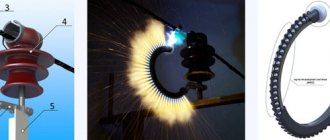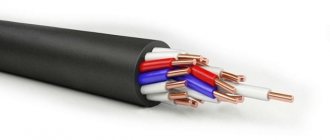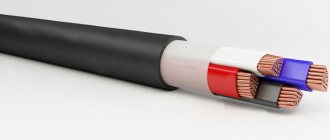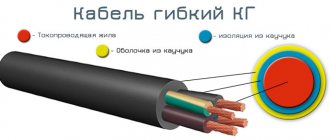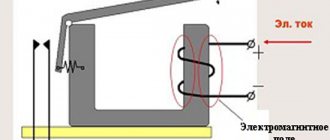For more information or to order products, please contact our managers.
RDIP-10 is a long-spark loop type arrester. The arrester is designed to protect overhead power lines (OHL) with a voltage of 6, 10 kV three-phase alternating current with bare and protected wires from induced lightning overvoltages.
The number of arresters successfully operated in many regions of Russia exceeds 1,000,000.
Beware, counterfeit! You can ask any questions regarding this topic by phone + 7 812 3270808 (ext. 159 or 139) or by mail.
Principle of operation
The operating principle of the arrester is based on the use of the sliding discharge effect, which provides a large length of pulse overlap along the surface of the arrester, and, due to this, as well as by dividing the discharge channel into parts by electrodes, preventing the transition of the pulse overlap into a power arc of industrial frequency current. When an induced overvoltage occurs on the overhead line wire, the spark gap between the clamp on the overhead line wire and the spark gap breaks through, and the voltage is applied to the insulation between the central tube of the loop and the insulation fittings having a support potential. Under the influence of an applied pulse voltage, a sliding discharge develops along the loop insulation surface from the central tube to the arrester mounting bracket (along one arm of the loop with electrodes). After the passage of the pulse current, the discharge goes out without turning into a power arc, which prevents the occurrence of a short circuit and shutdown of the overhead line.
Currently, RDIP-10-IV-UHL1 are increasingly used in various regions of the country during the construction of new, reconstruction and technical re-equipment of existing 6-10 kV overhead lines, in accordance with design solutions based on the necessary regulatory and technical documentation developed by the institute "JSC ROSEP" The number of arresters successfully operated in many regions of Russia exceeds 1,000,000.
RDIP-10 is designed to protect overhead power lines with a voltage of 6-10 kV three-phase alternating current with protected and bare wires from induced lightning overvoltages and their consequences, and is designed for operation outdoors at ambient temperatures from minus 60°C to plus 50° For 30 years.
Appearance
Principle of operation
The arrester consists of a metal rod bent into a loop, covered with a layer of high-pressure polyethylene insulation; intermediate ring electrodes are fixed on its surface (on one of the arms of the arrester). The ends of the insulated loop are fixed in a fastening clamp, with the help of which the arrester is attached to the insulator pin on the overhead line support. In the middle part of the loop there is a metal tube on top of the insulation. A universal clamp is attached to the overhead line wire, opposite the metal tube of the spark gap, to create the required air spark gap S.
The insulated arrester loop is secured to the overhead line using a fastening clamp. The fastening clamp is made of steel coated with a protective layer of zinc and has a design that ensures reliable fastening of the arrester to the elements of the overhead line fittings.
The design of the clamp for fastening the arrester can be changed and have a shape adapted to the specific conditions for mounting the arrester on the overhead line support. The universal wire clamp is made of steel coated with a protective layer of zinc. The design of the clamp allows it to be installed on both bare and protected wires, the clamp for which has biting spikes.
The principle of operation of the arrester is based on the use of the sliding discharge effect, which provides a large length of pulse overlap along the surface of the arrester, and due to this, preventing the transition of the pulse overlap into a power arc of industrial frequency current. When an induced lightning pulse occurs on the overhead line wire, the spark air gap S between the overhead line wire and the metal tube of the arrester breaks through, and voltage is applied to the insulation between the metal tube and the metal loop rod, which has a support potential. Under the influence of an applied pulse voltage, a sliding discharge develops along the insulation surface of the loop from the metal tube to the arrester mounting clamp (along the shoulder with intermediate electrodes). Due to the sliding discharge effect, the volt-second characteristic of the arrester is lower than the volt-second characteristic of the insulator, i.e. When exposed to lightning overvoltage, the arrester is closed, but the insulator is not. After the passage of the lightning pulse current, the discharge goes out without turning into a power arc, which prevents the occurrence of a short circuit, damage to the wire and disconnection of the overhead line. It was the implementation of the principle of a sliding discharge that served as a prerequisite for a high degree of reliability of the spark gap, resistance to destruction and a long service life (30 years).
Specifications
The discharge characteristics of RDIP-10 ensure that none of the insulators of all three phases in this circuit overlap, since each of them is protected by a spark gap installed electrically parallel to it and located either directly next to the insulator or on an adjacent support.
At levels of induced overvoltages close to the surge voltage of the arrester, it is possible that the arrester may close on only one support, leading to a single-phase ground fault. The short-circuit current does not exceed 10-20 A, and the loop arrester with a total overlap length of 80 cm is guaranteed to exclude the occurrence of a power arc.
| Voltage class | 10 kV |
| Surface overlap length | 78 cm |
| External spark gap | 2-4 cm |
| Pulse 50% discharge voltage, no more on positive polarity on negative polarity | 110 kV 90 kV |
| Coordination voltage with insulator SHF10-G * | 300 kV |
| Repeated impulse voltage withstood by internal insulation, not less | 50 pulses 300 kV |
| Withstand voltage of industrial frequency, not less dry under rain | 42 kV 28 kV |
| Repeatedly withstand pulse current 8¤20 µs, not less | 20 pulses 40 kA |
| Weight | 2.5 kg |
| Service life, not less | 30 years |
* The highest voltage with a standard pulse shape of 1.2/50 µs, at which the insulator is protected by the arrester, is called the “coordination voltage”.
Installation of RDIP-10-IV-UHL1
- Operating manual RDIP-10-IV-UHL1
- Certification RDIP-10-IV
Specifications
| Characteristic | RDIP-10 | |
| Voltage class, kV | 6, 10 | |
| Maximum continuous permissible operating voltage, kV | 12 | |
| Spark gap, mm | 20-40 | |
| Extinguishing the arc of a two-phase short-circuit current to ground with the effective value of the periodic component at the highest operating voltage of an overhead line up to 12 kV, kA | 0,6 | |
| Maximum amplitude of withstand pulse 8/20 µs, simulating a direct lightning strike, kA | 40 | |
| Pulse discharge voltage, kV | 120 | |
| One-minute alternating voltage, kV, not less: | ||
| - dry | 38 | |
| - under rain | 28 | |
| Length of overlap along the insulating surface, mm, not less | 360 | |
| Weight, kg | 2,4 | |
RDIP1-10-IV
The RDIP1 type arrester differs from RDIP-10-4 in the modified shape of the loop bend, fastening parts and the method of ensuring the gap between the arrester and the wire.
| Arrester RDIP1-10-IV UHL1 | |
| R | arrester |
| DI | long-spark |
| P | loop type |
| 1 | design (modified hinge bend shape) |
| 10 | network voltage class, kV |
| IV | creepage distance category |
| UHL | climatic version according to GOST 15150-69 |
| 1 | placement category according to GOST 15150-69 |
Installation
The arrester is installed on overhead lines with any types of supports and insulation.
On single-circuit overhead lines, to protect against induced overvoltages and their consequences, arresters are installed one on each support with regular sequential phase rotation. On double-circuit overhead lines, to protect against induced overvoltages and their consequences, 2 arresters are installed on each support, on one pair of phases of the same name, one arrester for each circuit, with the same principle of alternating protected phases as for single-circuit overhead lines.
At the same time, installing arresters on a support does not impose additional requirements on the presence of a grounding device and its resistance. The absence of additional requirements for grounding of supports is explained by the operating principle of RDIP-10 arresters. When a lightning overvoltage occurs, two arresters overlap on opposite phases, and an electrical circuit is formed that includes the grounding resistance of these two supports (Fig. 1). Thus, the presence of ground resistance on the supports helps limit the current passing through the arresters.
Figure 1 – Installation diagram of arresters on a single-circuit overhead line and illustration of their operation
RDIP arrester: characteristics
Dischargers are used throughout our country. They are effective and have a long service life. Loop-type long-spark arresters are used for lightning protection on high-voltage lines, while their wires are bare.
The arresters have undeniable advantages: they eliminate burnout of wires and effectively prevent the disconnection of high-voltage lines. They help eliminate the consequences caused by lightning flashovers. At such moments, overhead power lines are not damaged, the stations are also safe.
The next advantage is their economy. The response life of overhead line switches is significantly minimized, and during a thunderstorm, electrical networks are also under their protection and do not receive overvoltage. The arresters themselves cannot be destroyed during a lightning strike or short circuit. The devices do not require special maintenance, since they are not exposed to current voltage. There is no need for special requirements to reduce the grounding of supports.
The installation of the RDIP arrester must be carried out correctly and in accordance with all the necessary requirements; it is then that the occurrence of simultaneous overlap of two phases of one support will be excluded, and a short circuit between the phases will also be prevented. The arrester is installed one device on each side of the support, and it is necessary to alternate the phases.
The characteristics of the RDIP include a multiple withstand voltage of 50 pulses, a fairly low weight, which means ease of installation, and a service life of at least 30 years.
Comparison of RDIP and RMK arresters
| Characteristics | RDIP-10 | RMK-20 |
| Pulse 50% discharge voltage, kV (the lower it is, the better the coordination of the arrester with the insulator, even if the air gap is violated) | 100 | 85 |
| Possibility of use on overhead lines 6-10-15-20 kV | 6-10 | 6-10-15-20 |
| Accompanying current that can extinguish the spark gap, A | 600-800 | 1200 |
| Withstand pulse current 8/50 μs, not less, kA | 20 | 20 |
| Possibility of use on overhead lines with SIP or bare wire, on all types of supports and insulation | Yes | Yes |
| Possibility of installation under voltage | No | Yes |
| Product weight, kg | 2,55 | 1,00 |
| Packaging volume (10 pieces in a box), cubic meters. | 0,16 | 0,02 |
| Compact, rigid design, least susceptible to air gap disruption during operation | No | Yes |
| Degree of pollution according to GOST 9920 | IV | IV |
| Damage to arrester elements when triggered | No | No |
| Warranty period, years | 5 | 5 |
| Service life, years | 30 | 30 |
| Quality (Certificates and Declarations, Russia) | Yes | Yes |
| Quality control and testing of each product in production | Yes | Yes |
| Price | RMK is cheaper | |
RMK-20 has passed all the necessary tests and is certified.
Since the beginning of 2009, more than 100,000 units have been installed on overhead lines. RMK-20.
Arresters RDIM-10-1,5-IV
RDIM-10-1.5-IV arresters are designed to protect overhead power lines from lightning strikes, approaches to overhead line substations on wooden supports; in these cases, three arresters are installed per support for all phases; they are also used to protect overhead lines from induced overvoltages and installed one at a time on a support with alternating phases. The RDIM-10-1.5-IV arrester consists of two cable sections connected with clamps. Fastening to the support is done using a universal clamp, which is attached to the ends of the arrester.
| Arresters RDIM-10-1,5-IV UHL1 | |
| R | arrester |
| DI | long-spark |
| M | modular type |
| 10 | network voltage class, kV |
| 1,5 | surface overlap length |
| IV | creepage distance category |
| UHL | climatic version according to GOST 15150-69 |
| 1 | placement category according to GOST 15150-69 |
Arresters RDISH-10-IV
RDISH-10-IV arresters combine the functions of an arrester and a loop and can be installed instead of loop arresters. The arresters are installed one at a time on a support with phase alternation.
The RDISH-10-IV arrester consists of a piece of special cable with an aluminum core and cross-linked polyethylene insulation. Intermediate electrodes are installed on one arm to split the cable into separate sections. The arrester is attached to the insulators using a bracket strap and a metal tube installed in the middle part of the cable. To ensure the required spark gap, a rod electrode is installed to the insulator pin.
| Arresters RDISH-10-IV UHL1 | |
| R | arrester |
| DI | long-spark |
| Sh | loop type |
| 10 | network voltage class, kV |
| IV | creepage distance category |
| UHL | climatic version according to GOST 15150-69 |
| 1 | placement category according to GOST 15150-69 |
Arresters RDIM-10-K-II
RDIM-10-K-II arresters are designed for protection against induced overvoltages and burnout of overhead lines with insulated and protected wires of a compact design; one arrester is installed per support on the middle phase. The RDIM-10-K-II arrester consists of two sections of cable and an insulator in the form of a rubber bundle. The cable is attached to the insulator using metal bushings, forming three discharge modules. The insulator is equipped with end caps, with the help of which one end of the arrester is attached to the wire, the other to the support. The arrester is attached to the overhead line using a clamp, the shape of which can be changed and adapted to the specific mounting condition.
| Arresters RDIM-10-K-II UHL1 | |
| R | arrester |
| DI | long-spark |
| M | modular type |
| 10 | network voltage class, kV |
| K | for protecting overhead lines with compact wires |
| II | creepage distance category |
| UHL | climatic version according to GOST 15150-69 |
| 1 | placement category according to GOST 15150-69 |
